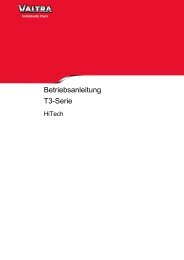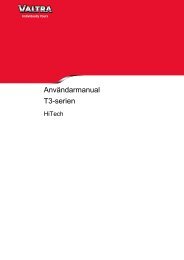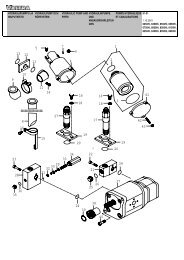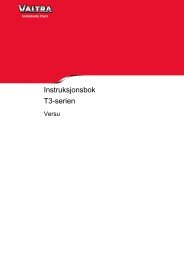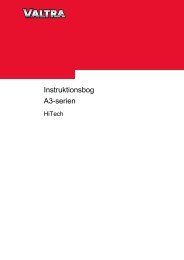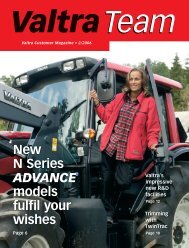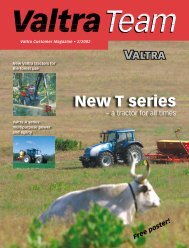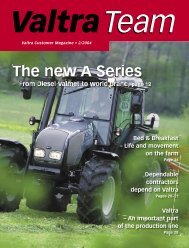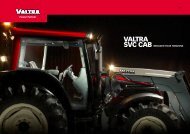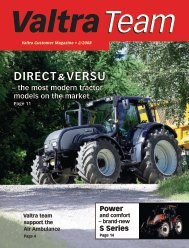New C Series - Valtra
New C Series - Valtra
New C Series - Valtra
- TAGS
- series
- valtra
- www.valtra.com
Create successful ePaper yourself
Turn your PDF publications into a flip-book with our unique Google optimized e-Paper software.
Dairy farmers adapt to succeed<br />
in a changing environment<br />
The agricultural sector continues to<br />
experience rapid changes. One of the<br />
biggest forces of change in the industry<br />
is the European Union and its agricultur-<br />
al policies. The development of producer<br />
prices has also been unfavourable. <strong>Valtra</strong><br />
Team interviewed dairy farmers in Swe-<br />
den, Denmark, Holland and Italy in order<br />
to fi nd how they are surviving amidst the<br />
ongoing changes.<br />
Questions<br />
1. Background information about your<br />
farm: Family, number of tractors, number<br />
and breed of cattle, average milk pro-<br />
duction kg/year/cow, contracting work<br />
expenses (% share of total machinery<br />
expenses), size of farm<br />
2. What are your main plans and goals at<br />
the moment for developing your farm?<br />
3. What is your opinion about current<br />
agricultural policy trends?<br />
4. How have the latest changes in agri-<br />
cultural policies affected operations on<br />
your farm?<br />
5. In your opinion, what are the main<br />
ways in which a farmer like yourself can<br />
survive amidst these changes?<br />
6. What are your intentions regarding your<br />
tractors in the future?<br />
22<br />
Sweden<br />
1. Sven-Olof and Marie Karlsson, two children<br />
– <strong>Valtra</strong> 8350 and 705-4<br />
– 70 cattle, currently being increased to 80<br />
– SRP, Svensk Röd and Vitbrokig Boskap (traditional<br />
Swedish breeds)<br />
– Milk production 10 500 kg /year/cow utilising<br />
2x4 tandem milking stations<br />
– Share of work off the farm represents 3 % of<br />
total machinery expenses<br />
– 300 hectares, including leased land<br />
– 80 hectares of hay, of which 15 hectares grazing<br />
land, 50 hectares of grain and 10 hectares of forest<br />
2. We will continue family farming with milk as our<br />
main produce. We hope to be able to increase the<br />
wellbeing of our animals and thus reduce veterinary<br />
costs.<br />
3. We have to accept the fact that agriculture in Sweden<br />
is part of an international environment and that<br />
we can no longer think only about the wishes and<br />
needs of our domestic market.<br />
4. Individual farmers have very little chance to infl uence<br />
policymaking. Since we have a relatively new<br />
cowshed, we shall continue milk production. We<br />
aim to produce the highest quality of milk with as<br />
low expenses as possible.<br />
5. Swedish farmers are fi ghting for the same things<br />
as farmers in other countries. The tax burden should<br />
be reduced along with other costs, such as the tax<br />
on diesel and various environmental charges.<br />
6. We already share machinery when it comes to<br />
harvesting the hay. We are also prepared to do more<br />
contracting work for others. At the moment we<br />
do round bailing and liquid manure spreading.<br />
Marie, Sven-Olof and their youngest son Henrik.<br />
Benedetto and his son Robert.<br />
Italy<br />
1. The Robilat farm is owned by the Tortoni family:<br />
father Benedetto (55), his wife, two sons and<br />
a daughter. In addition to both sons, two local men<br />
work on the farm.<br />
– <strong>Valtra</strong> 6400 and 8050<br />
– 240 Friesian cows<br />
– Milk production 12 000 kg/cow/year utilising<br />
a 10+10 herringbone milking parlour.<br />
– Share of work off the farm represents 25 %<br />
of total machinery expenses<br />
– 85 hectares, of which 30 hectares of hay and<br />
55 hectares of feed corn<br />
2. Plans for the farm are to increase production by<br />
raising the milk quota. This is diffi cult, however, as<br />
increasing the quota would require increasing the<br />
area of fi elds, and there is simply no more available<br />
land on the Robilat farm.<br />
3–4. According to Mr. Tortone, the family has continually<br />
increased milk quotas ever since the new<br />
cowshed was built in 1985. Each member of the<br />
family has his own area of responsibility on the<br />
farm. One of the sons takes care of feeding, while<br />
the other takes care of milking and artifi cial insemination.<br />
This is the main key to increasing milk production<br />
while at the same time improving quality.<br />
5. Mr. Tortone believes that the most important factor<br />
is the quality of the milk. Only after this comes<br />
quantity, which is used to pay for the fi xed costs of<br />
production.



